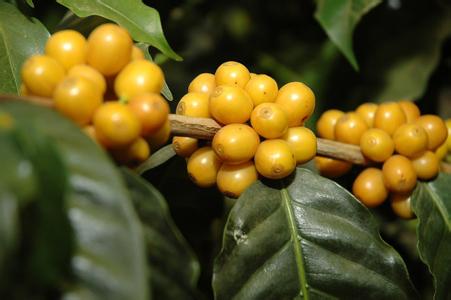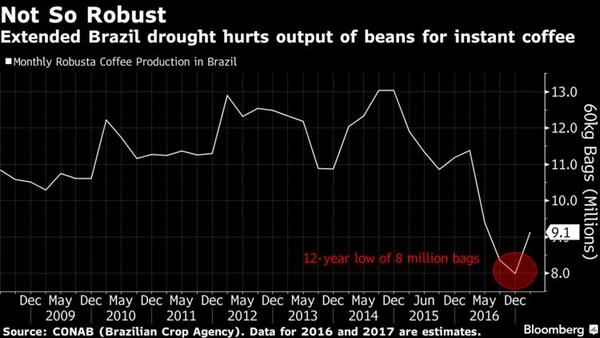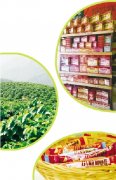The world's largest coffee exporter is going to import coffee. What's going on?

Mention Brazil, samba, carnival and, of course, coffee.
With its unique geographical location and natural conditions, coupled with hundreds of years of coffee cultivation history and traditional skills, Brazil has always occupied the top export position in the world coffee market. But now that things have changed, they are also thinking about importing coffee.
The export volume of Brazilian coffee has always been unmatched by other regions. For 2016 alone, the top five exporters were Brazil, Vietnam, Colombia, Indonesia and Honduras. Among them, Brazil accounts for 15% of the world's coffee exports.
Exports are based on production, and Brazil also leads the world in coffee production. The top five countries in global coffee production in 2016 are in line with their exports, with Brazil and Vietnam firmly in the top two.
Now, Brazil wants to import coffee, and the preferred source is Vietnam. Brazilian coffee companies hope to import coffee beans from Vietnam to meet their production needs. Vietnamese coffee is good and cheap, and more importantly, it has a stable production, and the variety is in line with the shortage of Brazilian coffee varieties: Robusta.
Robusta and Arabica are the two major varieties of coffee in the world, and the ratio of them has been stable at about 4:6 for a long time. The main difference between the two lies in particle size and growth position. Arabica is a variety of Starbucks raw materials with high mountain beans, small grains and low caffeine content; Robusta is low mountain beans, medium grains, high caffeine content and "strong". It is also the raw material variety of Nestl é instant coffee and many coffee products manufacturers in Brazil.
In Brazil, both varieties of coffee are grown, with Arabica growing over a larger area along the south-eastern coast of Brazil, while Robusta is mainly concentrated in ESP í rito Santo and Rond ô nia. The Alabica growing area is in good weather this year, but the Robusta growing area is not so lucky.
Production of Brazil's Robusta has fallen sharply recently because of days of drought. And this is not a short-term phenomenon. Brazil's Robusta coffee production has also experienced an overall decline in recent years. Since 2009, production has peaked at 1300 million bags (60 kg bags). In a normal year, Robusta's production has been stable at around 1100 million bags, while at the end of 2016, Brazil's Robusta production reached its lowest level in 12 years, producing only 8 million bags, which is difficult to meet demand, resulting in a continued rise in the price of raw beans in Brazil.

According to the official forecast of the Brazilian government, Robusta's annual production this year will maintain an annual growth rate of 21%, but the total production will still be below the all-time high. As a result, Temer's government intends to introduce foreign coffee, which has also caused different voices in Brazil.
Brazilian coffee product processors welcome Vietnamese coffee. For a long time, they are subject to local protection policies and can only use local Robusta as raw materials to make instant coffee. Now, once they liberalize the import of coffee raw materials, they have more choices. The use of lower-priced Vietnamese raw materials can also save costs.
But Brazil's local Robusta growers have expressed their dissatisfaction through various channels, saying repeatedly that they can complete the annual production as planned and will guarantee "the same price as Vietnamese coffee."
In a report earlier this year, Evair Vieira de Mello, a member of the Brazilian House of Commons representing ESP í rito Santo, the main producer of Robusta, told the Financial Times that the government's forecast of the inventory of Robusta in Brazil (less than 2 million bags) was wrong and that the actual inventory was 4.4 million bags, enough to supply the market.
The exchange of voices has intensified, and the Temer government, which is in a whirlpool of government trust, has not yet made a final decision. But there is a precedent for similar incidents. Last year, the Brazilian government granted a small authorization to buy coffee beans from neighboring Peru, but quickly cancelled it under pressure from local growers.
What will happen this time will only be revealed in time.
Important Notice :
前街咖啡 FrontStreet Coffee has moved to new addredd:
FrontStreet Coffee Address: 315,Donghua East Road,GuangZhou
Tel:020 38364473
- Prev

The store is small, but it is enough to keep you from moving.
Don't like Xing Dad's fast food consumption pattern, just like that kind of small literature and art, occasionally can install a forced coffee shop, order a cup of coffee and a few plates of snacks, as if you can sit forever. There are many Keqiao coffee shops, but the style similarity is too high. In the vast coffee shop, fennel beans finally found their favorite coffee shop, Autumn Rain Coffee, which is small enough for me to move.
- Next

Inheriting a hundred years of quality and creating Yunnan Classics
Because of its romantic and unique fragrance, coffee is listed as one of the three drinks in the world and is loved by the world. Although coffee is imported, it is widely grown in Yunnan. At present, coffee growing areas in the province have spread all over nine prefectures, cities and 35 counties and districts, including Dali, Pu'er, Baoshan, Dehong, Lincang, Wenshan, and Xishuangbanna, accounting for more than 99 percent of the country's output and about 1 percent of the world's total output.
Related
- Why are the coffee in some coffee shops not enough after being frozen? What should I make up for my American latte cappuccino coffee after being frozen?
- How much water does it take to steam coffee by hand? Why is the coffee brewing and steaming time 30 seconds? What is the purpose of steaming coffee?
- The suspected drink contains too much caffeine! Overlord Tea Lady responds urgently!
- Starbucks rejects antique paper coupons?! Netizen: Missed marketing opportunities!
- What ratio of water temperature and ground does the smart cup method use to press coffee? The difference between brewed coffee and filtered coffee?
- What is the standard process for the purpose of coffee cup testing? What is the difference between hand-brewed coffee and cup testing?
- How to use hand-brewed coffee paragon small golden balls? How does cold coffee lock in the aroma of coffee?
- Is American coffee black? What is the difference between American coffee and drip coffee?
- Unexpected! Well-known tea beverage brand Lele Tea will withdraw from the Zhengzhou market!
- Starbucks enters the fashion and beauty industry?! Netizen: Give me an ice American eye cream

